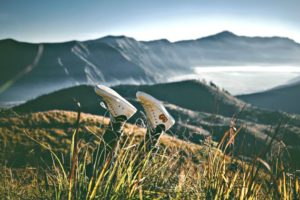Video Credit: Bunions: What in the World Causes Them? from Elizabeth Auger on Vimeo
Bunions (aka hallux valgus) are probably something you’ve never given much thought to – that is unless you’re unfortunate enough to have them. Bunions may seem to come out of nowhere while, in fact, they are the result of a foot injury, or an inherited structural foot defect, rheumatoid or other inflammatory type of arthritis, flat feet from cerebral palsy or obesity.
A 2011 study published in the journal, Arthritis Care and Research, showed 36% of participants had a bunion. They were more common with seniors and especially in women – very possibly due to the contributory factor of wearing narrow toe box shoes with elevated heels; sometimes for 8-10 hours a day.
Signs and Symptoms of a Bunion
When you notice a bony angular bump on the side of your foot – near the joint of your big toe – you probably have a bunion! There are also ‘bunionettes’ which occur near the small toe joint. It’s going to be very tender, swollen, red with possible numbness, with pain and burning near the base of the toe, as well as in the ball of your foot.
Bunion sufferers are also more likely to experience pain in other parts of their body as well; including the hip, knee, lower back and foot. Walking is difficult because your entire body rests on the bunion with each step. Over time, the bunion will begin to point your big toe toward your smaller ones.
More than Meets the Eye?
While thought of as merely a bump at the side of your big toe, this condition literally goes deeper, reflecting an actual modification in the anatomy of your foot.
Not always problematic, bunions are permanent without surgical intervention. They can, however, become worse from additional complications of hammertoe, bursitis, or metatarsalgia.
For a proper diagnosis, see your podiatrist for an x-ray and blood test (for arthritis). These tests will determine the best course of action; such as exercises, medication (OTC or otherwise), orthotics, surgery or alternative treatments.
Relieving Your Bunion Pain
Taping or splinting your foot into a normal position may reduce the stress on toes which are affected. Ice your foot by resting it on a frozen bag of corn or peas for 20 minutes twice a day. Ask your podiatrist which OTC (over the counter) medication will help with inflammation; sometimes an injected medicine is required to lessen the pain.
Your risk of developing bunions would also certainly be increased by wearing tight or pointy shoes which cramp your toes together. Proper fitting shoes should conform to your foot shape, without compressing any part of your toes, arch or heel. Custom fitted orthotics can provide added comfort, as might professional stretching of your shoes. Wear bunion pads to cushion the pain. Avoid activities that already aggravate your condition.
Surgical Treatment:
Of course when you have difficulty walking or are in constant pain, something more may be required. If all other remedies have been tried without effective relief, there’s always surgery. It can return your big toe back to its appropriate anatomical position. Your nerves, tendons, ligaments and bones will all be aligned in proper order, while the bunion bump will be permanently removed.
The Remarkable Human Foot
Unless we’ve experienced foot and ankles issues in our youth, we tend to take our feet for granted. They get us around, from here to there, no big deal. And yet, they’re everything, when injury or disease interferes with their function and flexibility.
Have you ever wondered how our feet can be so small yet so strong? Well, the facts below will give you just a small inkling of why ‘our feet are masterpieces of engineering’ (according to Leonardo Da Vinci).
What’s at work here?
- 26 bones with 33 joints – essentially, 25% of the total bones in the body;
- Each foot contains more than 100 muscles, tendons and ligaments;
- Location of the Achilles tendon, which connects your heel to your calf – and is the largest and thickest tendon in the body;
- Contains a network of blood vessels for 3 significant muscles –the large calf (gastrocnemius), lower calf (soleus), and sole (quadratus plantae);
- Over 200 thousand nerve endings – the densest composition in the whole body;
- Greater than 250 thousand sweat glands – secreting 16 ounces of sweat per day.
- The foot is designed to be flat on the ground, and has 2 primary functions; absorbing shock and propulsion.
Hopefully this post encourages you to research even more, and give your feet the love and care they deserve.
Holistic podiatry and preventative care has been practiced by Dr. Elizabeth E. Auger for nearly 2 decades. A New York native, Dr. Auger decided to open her Salt Lake City practice in 1999 because of her fondness for the Utah lifestyle. She is an avid sportswoman and runs, hikes and snowshoes in the Wasatch Mountains with her border collies by her side.

 Morton’s Neuroma is more correctly termed as
Morton’s Neuroma is more correctly termed as 